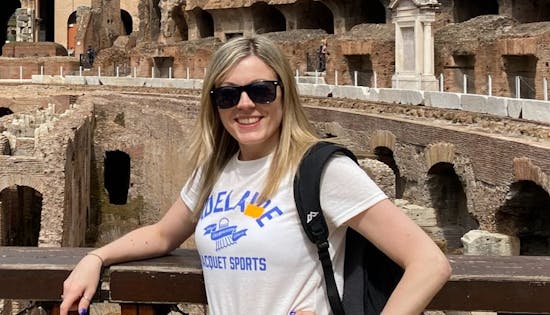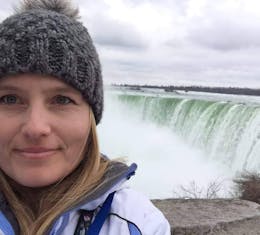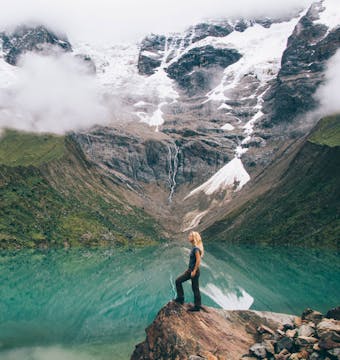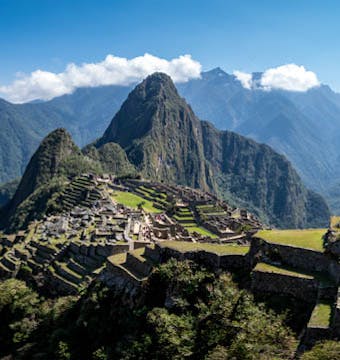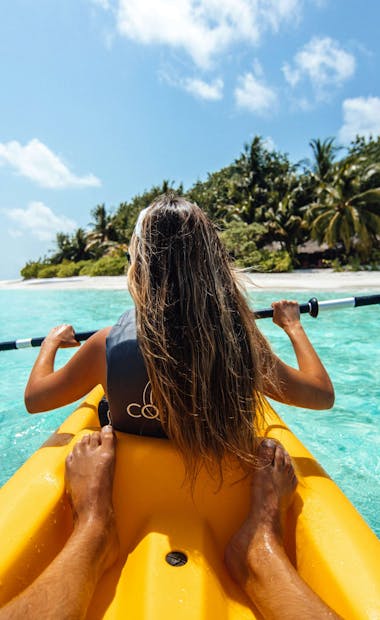The Salkantay Trek
The Salkantay Trek Is One Of The Best & Most Challenging in Peru!
Popular tours
- Save15%
 View Tour
View TourUltimate Salkantay Trek - 5 Days
- Cusco to Cusco
- Age group: 12 - 99
- Max group size: 12
Was:£461From£392 - Save1%
 View Tour
View TourSalkantay Trek to Machu Picchu with Glamping - 5 Days
- Cusco to Cusco
- Age group: 8 - 70
- Max group size: 16
Was:£638From£631 - Save26%
 View Tour
View TourSalkantay Trek & Machu Picchu - 5 Days
- Cusco to Cusco
- Age group: 12 - 100
- Max group size: 16
Was:£569From£422 - Save10%
 View Tour
View TourSalkantay Trek & Machu Picchu - 4 Days
- Cusco to Cusco
- Age group: 12 - 99
- Max group size: 10
Was:£410From£369 - Save1%
 View Tour
View TourSalkantay Trek & Machu Picchu - 7 Days
- Cusco to Cusco
- Age group: 15 - 99
- Max group size: 16
Was:£1,070From£1,059 - Save1%
 View Tour
View TourSalkantay Trek to Machu Picchu 5 Days / 4 Nights
- Cusco to Cusco
- Age group: 8 - 70
- Max group size: 16
Was:£638From£631
The Salkantay Trek
Embark on an awe-inspiring adventure that will take you to the heart of the Peruvian Andes, where towering peaks, emerald valleys, and ancient ruins await your exploration. Welcome to the legendary Salkantay Trek, a trekking experience that promises to leave you breathless in more ways than one. As you traverse this remarkable trail, you'll be immersed in nature's grandeur, encounter fascinating local culture, and witness the remnants of an ancient civilization.
The Salkantay Trek is not for the faint of heart, but for those seeking an unforgettable journey off the beaten path. Located in the Cusco region of Peru, this lesser-known route is gaining recognition as one of the most spectacular trekking adventures in the world. With its diverse landscapes, from snow-capped mountains to lush cloud forests, the Salkantay Trek offers a thrilling challenge for intrepid explorers and nature enthusiasts alike.
Your expedition begins in the picturesque town of Mollepata, where you'll meet your experienced and knowledgeable local guide. From here, you'll embark on a multi-day trek that will test your physical endurance while rewarding you with breathtaking vistas at every turn. The highlight of the trek is undoubtedly the magnificent Salkantay Mountain, standing proudly at a staggering altitude of 6,271 meters (20,574 feet). As you conquer high mountain passes, such as the formidable Salkantay Pass at 4,650 meters (15,255 feet), you'll be rewarded with panoramic views that will leave you in awe of nature's grandeur.
But it's not just the natural beauty that makes the Salkantay Trek so special. Along the way, you'll have the opportunity to engage with the local communities, where the traditions and way of life have remained largely unchanged for centuries. You'll witness firsthand the perseverance and resilience of the Andean people, as well as their warm hospitality. This cultural immersion adds a rich and authentic dimension to your journey, making it an experience that extends beyond the physical challenge of the trek itself.
To ensure your comfort and peace of mind, our travel agency offers small group guided treks on the Salkantay Trail. Our expert guides will lead you through the rugged terrain, sharing their knowledge of the region's flora, fauna, and history. With their assistance, you can focus on absorbing the incredible surroundings and relishing in the once-in-a-lifetime moments that this trek provides.
At the end of each day, you'll rest in comfortable and well-equipped campsites, where you can rejuvenate and bond with your fellow trekkers. As night falls, you'll be captivated by the brilliance of the star-studded sky, far away from the hustle and bustle of modern life. It's in these serene moments that you'll truly appreciate the simplicity and beauty of the natural world.
Whether you're an experienced hiker looking for a new challenge or a passionate traveler seeking a unique and immersive experience, the Salkantay Trek is an adventure that will leave an indelible mark on your soul. Join us on this extraordinary journey and discover the wonders of the Peruvian Andes like never before. Book your small group guided trek today and embark on an odyssey that will be etched in your memory forever.
How difficult is the Salkantay Trek?
The Salkantay Trek is considered to be a challenging trek that requires a good level of physical fitness and endurance. While it may not be as famous as the Inca Trail, it offers its own unique set of difficulties and rewards. The trek involves hiking through diverse terrains, including steep ascents, high mountain passes, rocky paths, and sometimes unpredictable weather conditions.
The highest point of the trek is the Salkantay Pass, which stands at an altitude of 4,650 meters (15,255 feet). The high altitude, combined with steep inclines, can make the trek physically demanding and may pose a challenge for some trekkers. It is important to acclimatize properly to the altitude before starting the trek, allowing your body to adjust to the reduced oxygen levels.
The duration of the trek is typically around 4 to 6 days, depending on the itinerary chosen. Each day involves several hours of hiking, with varying levels of difficulty. It is advisable to have some prior hiking experience and engage in regular physical exercise to prepare for the trek. Cardiovascular fitness, leg strength, and stamina will greatly contribute to your ability to enjoy the trek and overcome its challenges.
However, despite its difficulty, the Salkantay Trek is achievable for individuals with a reasonable fitness level and a determined mindset. The reward of reaching the breathtaking viewpoints, immersing yourself in the stunning natural landscapes, and exploring the ancient ruins along the way make the effort worthwhile. It is essential to pace yourself, stay hydrated, and listen to the guidance of your experienced trekking guide to ensure a safe and enjoyable experience.
Ultimately, while the Salkantay Trek is challenging, it offers an extraordinary opportunity to connect with nature, push your limits, and create lasting memories. With proper preparation, determination, and the right mindset, you can conquer the Salkantay Trek and experience the profound beauty of the Peruvian Andes.
What Is The Salkantay Route like?
It is generlly agreed that the Salkantay route is spectacular with many people preffering this route to that of the Inca Trail. The Salkantay route takes you through the Cloud Forest and up the the high mountains. During the trek you'll pass through unfrequented areas and see more of the local culture as well as be rewarded with a spectacular view of 'The Savage Mountain' also know as 'Salkantay'! the second highest mountain in the local area around Cusoco and standing at over 6,000 meters.
Here is an image of the route which gives you a good idea of ascent, descent and distances:
How High Is The Salkantay Pass?
The Salkantay Trek reaches impressive altitudes as it winds its way through the Peruvian Andes. The highest point of the trek is the renowned Salkantay Pass, which stands at approximately 4,650 meters (15,255 feet) above sea level. This high-altitude pass offers trekkers breathtaking panoramic views of the surrounding mountain peaks, including the majestic Salkantay Mountain itself, which towers at an impressive 6,271 meters (20,574 feet).
Throughout the trek, you'll experience various altitude levels, with campsites and stops along the way situated at different elevations. The starting point of the trek in Mollepata is around 2,800 meters (9,186 feet) above sea level, and as you ascend towards the pass, you'll gradually reach higher altitudes. Acclimatization to the altitude is crucial to ensure your safety and well-being during the trek. It's recommended to spend a few days in Cusco or other nearby locations prior to starting the trek, allowing your body to adjust to the reduced oxygen levels at high altitudes.
The significant elevation gain during the Salkantay Trek adds to the challenge and adventure of the journey, but it also rewards trekkers with awe-inspiring vistas and a sense of accomplishment. The experience of trekking through such lofty heights amidst the stunning Andean landscapes is truly unforgettable and allows you to connect with the natural wonders of this remarkable region.
It's important to note that altitude sickness can be a concern for some individuals at high altitudes. Symptoms may include headaches, dizziness, nausea, and fatigue. Proper acclimatization, staying hydrated, and listening to the guidance of your trekking guide can help minimize the risks associated with altitude. Choosing a reputable travel agency that prioritizes safety and employs experienced guides will ensure that you receive the necessary support and information to navigate the high-altitude sections of the Salkantay Trek.
In summary, the Salkantay Trek offers an opportunity to trek at substantial altitudes, with the Salkantay Pass reaching approximately 4,650 meters (15,255 feet) above sea level. It's a remarkable journey that showcases the awe-inspiring beauty of the Peruvian Andes and rewards trekkers with unforgettable views and a sense of accomplishment.
Salkantay Trek Vs The Inca Trail
The Salkantay Trek and the Inca Trail are both popular trekking routes in Peru that lead to the iconic ancient city of Machu Picchu. While they share the destination, there are several key differences between the two treks in terms of difficulty, scenery, popularity, and accessibility.
Difficulty: The Salkantay Trek is generally considered to be more challenging than the Inca Trail. The Salkantay Trek involves higher altitudes, with the highest point at the Salkantay Pass reaching approximately 4,650 meters (15,255 feet). It also covers a greater distance and includes varied terrain, such as steep ascents, rocky paths, and potentially unpredictable weather conditions. On the other hand, the Inca Trail is relatively shorter and involves less strenuous climbs, making it more accessible for a wider range of fitness levels.
Scenery: Both treks offer stunning natural landscapes, but the Salkantay Trek showcases a greater diversity of scenery. It takes trekkers through snow-capped mountains, high mountain passes, lush cloud forests, and remote Andean villages. The Salkantay Trek allows for a more immersive experience in nature, while the Inca Trail offers a mix of mountain views, cloud forests, and Inca ruins along the way.
Popularity: The Inca Trail is significantly more popular and well-known than the Salkantay Trek. The Inca Trail has limited permits available per day, which means it can get crowded during the high season. Conversely, the Salkantay Trek is less crowded and offers a more secluded experience, especially during the off-peak season. If you prefer a quieter trek with fewer fellow hikers, the Salkantay Trek might be the better option.
Accessibility and Permits: The Inca Trail requires obtaining permits in advance, and there are restrictions on the number of trekkers allowed per day. These permits often need to be secured several months in advance due to high demand. On the other hand, the Salkantay Trek does not require permits, making it a more flexible option for those who prefer to book their trek on shorter notice or during the peak season when Inca Trail permits may be limited.
Cultural Experience: The Inca Trail provides a more immersive experience in terms of Inca history and culture. Along the trail, trekkers pass through various Inca ruins, including Wiñay Wayna, Intipata, and the Sun Gate, before reaching the majestic Machu Picchu. The Salkantay Trek also offers glimpses of local Andean culture and the opportunity to interact with remote communities, but the cultural focus is not as prominent as on the Inca Trail.
In summary, the Salkantay Trek is a more challenging and diverse trek that offers a secluded and immersive nature experience. It is an excellent choice for those seeking a more physically demanding adventure. On the other hand, the Inca Trail is a classic trek that combines beautiful scenery with a rich cultural experience. It is more accessible and popular, making it a good option for those who want to follow the footsteps of the ancient Incas.
Salkantay Trek Packing List
Here is a list f items you should consider for your trek on the Salkantay route:
- Your passport - not a copy!
- 1 day pack, and 1 large backpack to hold everything else. Your guides will carry the larger pack so with two bags you can split up what you need.
- 1 sleeping bag –it can get very chilly at night (-10 anyone so make sure you have a god sleeping bag.
- Good Hiking boots. You'll want boots with good support and try to wear them in a bit before your trek.
- 6 pairs of socks. Yes - extra socks! It's nice at the end of the day to change into a new par of socks. You'll also want heavy hiking socks and something lighter.
- 2 pairs of long underwear for the cold night, 1 super thick, 1 capeline midweight–which is perfect
- Enough pairs of pants - Make sure you spray them with insect repellent spray before the trip - you're welcome.
- 2 to 3 t-shirts, 2 long sleeve shirts.
- Ourwear Layers - the number of layers will vary by person but a hoodie, fleece layer and jacket will be required
- 1 Waterproof Jacket / 1 Warm jacket - The weather can change quickly so you're going to need something waterproof just incase. The big coat is for he cold night, night 1!
- Snacks - The trek is long, you'll need things to munch!
- Money - there are no cash points here so make sure you have something just in case.
- Tissues and wet wipes.
- Swimming Gear - Nights 3 and 4 are near hot springs, so if you plan to go, bring one. You can rent towels at the hostel or hot springs for 1 or 2 soles, which frees up a lot of backpack space.
- 1 pair of flip flops
- Toothbrush, toothpaste, etc
- Insect spray with 30% DEET - ESSENTIAL ITEM
- Head lamp or torch
- Camera
- Iron tablets and pills for altitude sickness.
- A watch with an alarm.
- Sun screen,
- Imodium AD or something for your stomach.
- Sunglasses
- Hat
How much time do I spend at Machu Picchu?
The amount of time you spend at Machu Picchu can vary depending on your personal preference, the type of tour or ticket you have, and the logistics of your visit. Here are a few factors to consider:
Guided Tour: If you opt for a guided tour of Machu Picchu, the duration of the tour can typically range from 2 to 3 hours. A knowledgeable guide will lead you through the site, providing historical and cultural insights while taking you to the main highlights and viewpoints. This guided experience allows you to learn about the significance of the different structures and gain a deeper understanding of the ancient city.
Self-Guided Exploration: If you prefer to explore Machu Picchu at your own pace, without a guide, you'll have more flexibility in terms of time. With a general admission ticket, you can enter the site during the designated time slot and explore independently. This allows you to spend as much time as you like exploring the various areas, taking in the breathtaking views, and immersing yourself in the ambiance of this UNESCO World Heritage site. Many visitors spend around 4 to 6 hours exploring Machu Picchu on their own.
Hiking Options: If you choose to incorporate additional hikes into your visit, such as climbing Huayna Picchu or Machu Picchu Mountain, you'll need to allocate extra time for those activities. These hikes offer unique vantage points and perspectives of Machu Picchu but require separate permits and have specific time slots. Huayna Picchu usually takes around 2 to 3 hours to complete, while Machu Picchu Mountain can take around 3 to 4 hours.
It's important to note that the duration of your visit may also be influenced by any time restrictions set by your tour operator, transportation schedules, or site regulations. Keep in mind that Machu Picchu is a popular tourist destination, and during peak seasons, there may be time limits imposed to manage visitor numbers.
Ultimately, the time you spend at Machu Picchu is up to you. It's recommended to plan your visit in a way that allows you to fully appreciate the site, take in the breathtaking scenery, and absorb the historical and cultural significance of this extraordinary place. Whether you choose a guided tour or prefer to explore independently, Machu Picchu offers an unforgettable experience that will leave a lasting impression.
How much is the Salkantay Trek?
It is possible to trek the Salkantay route on your own but we'd strongly encourage you not to and we say this even if you don't book with us.
There are many benefits to trekking with a guide and a small group not least safety, having company, having a safety net, not getting lost:)
What is the best time to do the Salkantay Trek?
The cost of the Salkantay Trek can vary depending on several factors, such as the tour operator you choose, the duration of the trek, the level of service provided, and any additional activities or services included in the package. Typically, the price range for the Salkantay Trek starts from around $500 USD per person for a basic package and can go up to $1,200 USD or more for a premium experience.The price of the trek generally includes services such as transportation to and from the trek starting point, a professional guide, meals during the trek, camping equipment (tent, sleeping bag, mattress), entrance fees to Machu Picchu, and sometimes additional activities like hot springs or a visit to the Humantay Lake. However, it's important to carefully review the details of the package you are considering to understand exactly what is included.
It's worth noting that the cost of the trek does not typically cover expenses such as flights to Cusco, accommodation in Cusco or Aguas Calientes (the town at the base of Machu Picchu), personal travel insurance, gratuities, or any additional services or experiences not mentioned in the package.
When selecting a tour operator, it's advisable to compare prices, read reviews, and ensure that the company is reputable and provides a high level of service and safety. Additionally, consider factors such as the quality of camping equipment, the experience and knowledge of the guides, and the group size. Opting for a smaller group size can often result in a more personalized and enjoyable experience.
Remember, the price of the Salkantay Trek is an investment in a memorable adventure and the opportunity to explore one of the most incredible trekking routes in the world. By choosing a reputable tour operator, you can ensure a well-organized and enriching experience as you conquer the stunning landscapes and cultural wonders of the Salkantay Trek.
What is the highest point on th4e Salkantay Trek?
The highest point on the Salkantay Trek is the Salkantay Pass, also known as the Abra Salkantay. It stands at an impressive altitude of approximately 4,650 meters (15,255 feet) above sea level. The Salkantay Pass is a significant milestone on the trek and offers trekkers breathtaking panoramic views of the surrounding snow-capped mountains and the awe-inspiring Salkantay peak itself, which towers at 6,271 meters (20,574 feet).
Reaching the Salkantay Pass is a rewarding accomplishment for trekkers, as it marks the culmination of the challenging ascent and represents the highest point of elevation along the trek. From the pass, you can witness the majestic beauty of the Andean landscapes and take in the serenity of the high-altitude environment.
It's important to note that trekking at high altitudes presents challenges, such as reduced oxygen levels and potential symptoms of altitude sickness. Proper acclimatization, staying hydrated, and listening to the guidance of your trekking guide are crucial for a safe and enjoyable experience.
The Salkantay Pass is a highlight of the Salkantay Trek, and standing atop this lofty point provides trekkers with a profound sense of accomplishment and an opportunity to marvel at the natural wonders of the Peruvian Andes.
How long is the Salkantay Trek?
The length of the Salkantay Trek can vary depending on the specific itinerary chosen and the pace of the trekking group. Typically, the Salkantay Trek spans a duration of 4 to 6 days, covering a distance of approximately 70 to 75 kilometers (43 to 47 miles).
The trek usually begins in the town of Mollepata, which is located at an altitude of around 2,800 meters (9,186 feet) above sea level. From there, trekkers embark on a multi-day journey through diverse landscapes, including mountain passes, cloud forests, and valleys, before reaching the final destination of Machu Picchu.
The daily hiking distances can vary, ranging from around 10 to 20 kilometers (6 to 12 miles), depending on the specific itinerary and camping spots chosen by the tour operator. Each day typically involves several hours of hiking, with varying levels of difficulty and terrain.
It's important to note that the duration and difficulty of the trek can be influenced by factors such as the fitness level of the participants, the pace of the group, and the time allocated for acclimatization to the high altitudes. It's recommended to engage in regular physical exercise and consider some pre-trek acclimatization in Cusco or other nearby locations to ensure a more comfortable and enjoyable experience.
Choosing a reputable travel agency that offers small group guided treks can provide you with a well-planned itinerary, experienced guides, and necessary support throughout the journey. They will help manage logistics, provide meals and accommodations, and ensure your safety, allowing you to focus on the incredible adventure and natural beauty of the Salkantay Trek.
Is the Salkantay Trek dangerous?
The Salkantay Trek, like any outdoor adventure, carries inherent risks and challenges. However, with proper preparation, adherence to safety guidelines, and the guidance of experienced trekking guides, the Salkantay Trek can be a safe and rewarding experience. Here are some considerations regarding safety on the Salkantay Trek:
Altitude: One of the main challenges of the Salkantay Trek is the high altitude. Altitude sickness is a potential concern, especially at the highest point of the trek, the Salkantay Pass. It's crucial to acclimatize properly before starting the trek by spending a few days in Cusco or other high-altitude locations. Adequate hydration, gradual ascent, and paying attention to your body's signals are important for managing altitude-related risks.
Weather Conditions: The weather in the Andean region can be unpredictable, especially at higher altitudes. Trekkers may encounter rain, fog, wind, or even snow, depending on the season. It's essential to pack appropriate clothing and gear to stay warm, dry, and protected from the elements. Additionally, trekking during the rainy season (November to April) can bring slippery and muddy trails, so caution is advised.
Physical Fitness and Stamina: The Salkantay Trek involves several days of hiking, often through challenging terrain, steep ascents, and descents. Good physical fitness, endurance, and prior hiking experience are recommended to better handle the demands of the trek. Regular exercise and training leading up to the trek can help prepare your body for the physical exertion.
Guided Tours and Safety Measures: Opting for a reputable travel agency that offers guided tours with experienced guides is highly recommended. Professional guides are familiar with the trek, its challenges, and safety protocols. They provide assistance, monitor the group's well-being, and offer guidance on trail conditions and potential hazards. It's crucial to choose a company that prioritizes safety, has a good track record, and provides necessary equipment and emergency support.
Personal Precautions: Trekkers should take personal precautions such as staying hydrated, using sunscreen, wearing appropriate footwear, and following the guidance of their guides. It's important to listen to your body, communicate any discomfort or symptoms to your guide, and be aware of the signs of altitude sickness or other health concerns.
By being adequately prepared, selecting a reputable tour operator, and taking necessary safety precautions, the risks associated with the Salkantay Trek can be mitigated. Thousands of trekkers successfully complete the trek each year, enjoying the stunning landscapes, cultural experiences, and a sense of accomplishment.
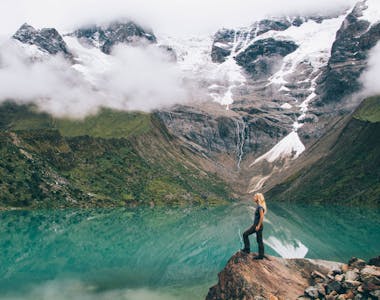
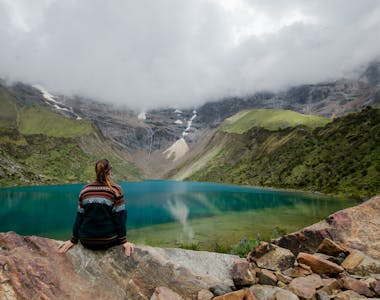
Salkantay Trek Highlights
Book With Confidence
Monthly Payments
Spread the costs with no interest or additional fees
Best Price Guarantee
We won't be beaten on price. If you find this adventure at a lower price please get in touch!
Reserve now & pay later
Reserve your adventure today and pay later, free of charge
ATOL protected
Book with confidence
Hold your space today, for free
or book your trip with a deposit and then pay the rest in instalments.
Reserve your flights with us
Add flights to your booking and we'll take care of the rest. You'll get 24/7 support from our team & ATOL protection.
Speak to our experts
Call or email our expert team to find out more and help with ideas and planning.
